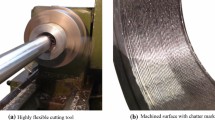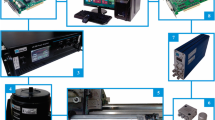Abstract
Boring bars for single-point turning on a lathe are particularly susceptible to chatter and have been the subject of numerous studies. Chatter is, in general, caused by instability. Clearly, the cutting process can be limited to regions of known stable operation. However, this severely constrains the machine-tool operation and causes a decrease in productivity. The more aggressive approach is to attack the stability problem directly through application of vibration control. Here, we demonstrate a new biaxial vibration control system (VPI Smart Tool) for boring bars. We present the experimentally determined modal properties of the VPI Smart Tool and demonstrate how these properties may be used to develop models suitable for chatter stability analysis, simulation, and development of feedback compensation. A phenomenological chatter model that captures much of the rich dynamic character observed during experiments is presented. We introduce the notion that the mean cutting force changes direction as the width of cut increases due to the finite nose radius of the tool. This phenomenon is used to explain the progression from chatter that is dominated by motions normal to the machined surface at small widths of cut to chatter that is dominated by motions tangential to the machined surface at large widths of cut. We show experimental evidence to support our assertion that a biaxial actuation scheme is necessary to combat the tendency of the tool to chatter in both directions. We then present some preliminary theoretical results concerning the persistence of subcritical instability as we expand consideration to high-speed machining.
Similar content being viewed by others
References
Rivin, E. I. and Kang, H., ‘Improvement of machining conditions for slender parts by tuned dynamic stiffness of tool’, International Journal of Machine Tools Manufacturing 29, 1989, 361–376.
Kelson, Z. Y. and Hsueh, W. C., ‘Suppression of chatter in inner-diameter cutting’, JSME International Journal Series C: Dynamics, Control, Robotics, and Design Manufacturing 39, 1996, 25–33.
Tobias, S. A., Machine Tool Vibration, Wiley, New York, 1965.
Sexton, J. S., Milne, R. D., and Stone, B. J., ‘A stability analysis of single-point machining with varying spindle speed’, Applied Mathematical Modelling 1, 1977, 310–318.
Takemura, T., Kitamura T., Hoshi, T., and Okushima, K., ‘Active suppression of chatter by programmed variation of spindle speed’, Annals of the International Institution for Production Engineering Research 23, 1974, 121–122.
Nachtigal, C. L., Klein, R. G., and Maddux, K. C., ‘Apparatus for controlling vibrational chatter in a machinetool utilizing an updated synthesis circuit’, U.S. Pat. No 3.967.515, 1976.
Matsubara, T., Yamamoto, H., and Mizumoto, H., ‘Chatter suppression by using piezoelectric active damper’, in ASME Design Engineering Division, DE-Vol. 18–2, ASME, New York, 1989, pp. 79–83.
Tewani, S. G., Rouch, K. E., and Walcott, B. L., ‘A study of cutting process stability of a boring bar with active dynamic absorber’, International Journal of Machine Tools Manufacturing 35, 1995, 91–108.
Rouch, K. E., Tewani, S., Walcott, B. L., Massa, T. R., Stephenson, R. W., and Stephens, L. S., ‘Active vibration control device’, U.S. Patent No. 5.170.103, 1992.
Browning, D. R., Golioto, I., and Thompson, N. B., ‘Active chatter control system for long-overhang boring bars’, in Proceedings of the SPIE Smart Structures and Materials Conference, San Diego, CA, Vol. 3044, 1997, pp. 270–280.
Redmond, J. and Barney, P., ‘Development and testing of an active boring bar for increased chatter immunity’, Sandia Report, SAND97–2860, UC-1420, 1997.
Pratt, J. R. and Nayfeh, A. H., ‘Active vibration control for chatter suppression’, in Proceedings of the 38th AIAA Structures, Structural Dynamics, and Materials Conference, Kissimmee, FL, 1997, AIAA Paper No. 97–1210.
Pratt, J. R. and Nayfeh, A. H., ‘Boring bar chatter control using a two-axes active vibration absorber scheme’, in Proceedings of NoiseCon97, Book 2, 1997, pp. 313–324.
Pratt, J. R. and Nayfeh, A. H., ‘Experimental system identification and active vibration control of a smart machine tool’, in Proceedings of the Eleventh Symposium on Structural Dynamics and Controls, Blacksburg, VA, L. Meirovitch (ed.), 1997, pp. 389–398.
Salje, E., ‘Self-excited vibrations of systems with two degrees of freedom’, Transactions of the ASME 78, 1956, 737–748.
Ewins, D. J., Modal Testing: Theory and Practice, Research Studies Press, Letchworth, England, 1986.
Tlusty, J., ‘Machine dynamics’, in Handbook of High Speed Machining Technology, R. I. King (ed.), Chapman and Hall, New York, 1985, pp. 48–153.
Kuchma, L. K., ‘Boring bars with improved resistance to vibration’, Engineering Digest 18, 1957, 68–70.
Koeingsberger, F. and Tlusty, J., Machine Tool Structures, Vol. 1, Pergamon Press, Oxford, 1970.
Grabec, I., ‘Chaotic dynamics of the cutting process’, International Journal of Machine Tools Manufacturing 28, 1988, 19–32.
Wu, D.W. and Liu, C. R., ‘An analytical model of cutting dynamics. Part 1: Model building’, ASME Journal of Engineering for Industry 107, 1985, 107–111.
Lin, J. S. and Weng, C. I., ‘A nonlinear dynamic model of cutting’, International Journal of Machine Tools Manufacturing 30, 1990, 53–64.
Hooke, C. J. and Tobias, S. A., ‘Finite amplitude instability-A new type of chatter’, in Proceedings of the 4th International Machine Tool Design Research Conference, Manchester, 1964, pp. 97–109.
Hanna, N. H. and Tobias, S. A., ‘A theory of nonlinear regenerative chatter’, ASME Journal of Engineering for Industry 96, 1974, 247–255.
Nayfeh, A. H., Chin, C.-M., and Pratt, J., ‘Perturbation methods in nonlinear dynamics-Applications to machining dynamics’, ASME Journal of Manufacturing Science Engineering 119, 1997, 485–493.
Pratt, J. and Nayfeh, A. H., ‘Experimental stability of a nonlinear time-delay system’, in Proceedings of the 37th AIAA Structures, Structural Dynamics, and Materials Conference, Salt Lake City, UT, 1996, AIAA Paper No. 96–1643.
Nayfeh, A. H., Chin, C.-M., and Pratt, J., ‘Applications of perturbation methods to tool chatter dynamics’, in Dynamics and Chaos in Manufacturing Processes, F. C. Moon (ed.), Wiley, New York, 1998, pp. 193–213.
Shi, M. and Tobias, S. A., ‘Theory of finite amplitude machine tool instability’, International Journal of Machine Tools Manufacturing 24, 1984, 45–69.
Stabler, G. V., ‘The chip flow law and its consequences’, in Advances in Machine Tool Design and Research, Oxford, Pergamon, 1964, p. 243.
Kalpakjian, S., Manufacturing Engineering and Technology, 2nd edition, Addison-Wesley, New York, 1992.
Nayfeh, A. H. and Pratt, J. R., ‘Chatter identification and control for a boring process’, in Proceedings of the IUTAM Symposium on New Applications of Nonlinear and Chaotic Dynamics in Mechanics, Ithaca, New York, F. C. Moon (ed.), 1997, pp. 193–202.
Juang, J.-N. and Phan, M., ‘Robust controller designs for second-order dynamic systems: A virtual passive approach’, Journal of Guidance, Control, and Dynamics 15, 1992, 1192–1198.
Goh, C. J. and Caughey, T. K., ‘On the stability problem caused by finite actuator dynamics in the control of large space structures’, International Journal of Control 41, 1985, 787–802.
Pratt, J. R. and Nayfeh, A. H., ‘Bifurcation control with application to high-speed machining’, in preparation.
Author information
Authors and Affiliations
Rights and permissions
About this article
Cite this article
Pratt, J.R., Nayfeh, A.H. Design and Modeling for Chatter Control. Nonlinear Dynamics 19, 49–69 (1999). https://doi.org/10.1023/A:1008322520352
Issue Date:
DOI: https://doi.org/10.1023/A:1008322520352




